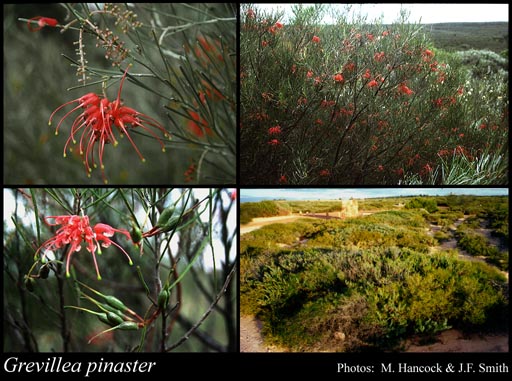- Reference
- Hooker's J.Bot.Kew Gard.Misc. 7:76 (1855)
- Conservation Code
- Not threatened
- Naturalised Status
- Native to Western Australia
- Name Status
- Current
Erect, spreading shrub, 0.5-3 m high, up to 3 m wide. Fl. red-pink-purple, Mar or May to Oct. White/grey/yellow or red sand, sandy clay, loam, laterite.







Scientific Description
Shrubs, 2-3 m high; branchlets hairy, not glaucous. Leaves alternate, 20-55 mm long, 1-2 mm wide, glabrous; lamina flat, more or less the same width throughout, entire; lobes 10-40 mm long, 0.5-2 mm wide, the margins flat or revolute, enclosing the lower surface of the leaf blade, forming a groove either side of the midvein. Inflorescences terminal, red or pink; pedicels 3-4 mm long. Perianth 7-9 mm long; tepals all free after flower opens, glabrous; ovary glabrous, stipitate, the stipe 2-3 mm long; pistil 20-25 mm long, red or pink, pollen presenter oblique, style glabrous. Follicles glabrous, not viscid, dehiscent, 10-13 mm long. Flowers in May, June, July, August or September. Occurs in the Eremaean (ER) or South-west (SW) Botanical Province(s), in the Yalgoo (YAL), Geraldton Sandplains (GS) or Avon Wheatbelt (AW) IBRA subregion(s).
Distribution
- IBRA Regions
- Avon Wheatbelt, Geraldton Sandplains, Swan Coastal Plain.
- IBRA Subregions
- Geraldton Hills, Lesueur Sandplain, Merredin, Perth.
- IMCRA Regions
- Central West Coast, Zuytdorp.
- Local Government Areas (LGAs)
- Carnamah, Chapman Valley, Coorow, Dalwallinu, Greater Geraldton, Morawa, Northampton, Swan.